
eBook - ePub
From Children's Interests to Children's Thinking
Observe, Document, Reflect, Plan
Jane Tingle Broderick, Seong Bock Hong
This is a test
Share book
- English
- ePUB (mobile friendly)
- Available on iOS & Android
eBook - ePub
From Children's Interests to Children's Thinking
Observe, Document, Reflect, Plan
Jane Tingle Broderick, Seong Bock Hong
Book details
Book preview
Table of contents
Citations
About This Book
Learn how to connect your curriculum planning to children's interests and thinking.
With this book, educators will discover a systematic way for using documentation to design curriculum that emerges from children's inquiries, what they wonder, and what they want to understand. Get strategies for designing a classroom environment at the start of the year to facilitate emergent inquiry curriculum. Each chapter guides teachers to document and reflect on their thinking through each of the five phases of a cycle of inquiry process, including observing, interpreting the meaning of the play they see, and developing questions to engage children.
Frequently asked questions
How do I cancel my subscription?
Can/how do I download books?
At the moment all of our mobile-responsive ePub books are available to download via the app. Most of our PDFs are also available to download and we're working on making the final remaining ones downloadable now. Learn more here.
What is the difference between the pricing plans?
Both plans give you full access to the library and all of Perlego’s features. The only differences are the price and subscription period: With the annual plan you’ll save around 30% compared to 12 months on the monthly plan.
What is Perlego?
We are an online textbook subscription service, where you can get access to an entire online library for less than the price of a single book per month. With over 1 million books across 1000+ topics, we’ve got you covered! Learn more here.
Do you support text-to-speech?
Look out for the read-aloud symbol on your next book to see if you can listen to it. The read-aloud tool reads text aloud for you, highlighting the text as it is being read. You can pause it, speed it up and slow it down. Learn more here.
Is From Children's Interests to Children's Thinking an online PDF/ePUB?
Yes, you can access From Children's Interests to Children's Thinking by Jane Tingle Broderick, Seong Bock Hong in PDF and/or ePUB format, as well as other popular books in Éducation & Programmes d'enseignement. We have over one million books available in our catalogue for you to explore.
Information
Topic
ÉducationSubtopic
Programmes d'enseignementCHAPTER 1
Setting Up the Classroom for Emergent Inquiry
Emergent inquiry is within your reach. Some basic principles for classroom design, scheduling, and planning for a long-term inquiry are outlined in this chapter. By the time you finish it, you’ll have a clear understanding of how you can prepare your environment for this dynamic learning and teaching cycle. To get there, we’ll begin by looking at the broad concepts involved in creating this space for inquiry in order to set a foundation. As you move through the cycle, you’ll come back to the processes in this chapter again and again, acting on what you’ve learned by observing, documenting, and interpreting to extend the children’s inquiry.
Learning Centers
An overall goal of arranging the environment for emergent inquiry curriculum is to organize learning spaces where children can be protagonists, independently developing relationships with people and using materials to translate their thinking and responses into many different languages, or ways of understanding and expressing their thinking about the world (Curtis 2017). Start by planning for learning centers organized around content that is typically identified as developmentally appropriate—that is, it promotes children’s learning through practices that build on children’s strengths and are appropriate to each child’s culture, language, and abilities (NAEYC 2009). These centers might include a dramatic play center, a library center, a manipulatives center, a sensory center perhaps with a focus on science, a block center, a quiet center, and an art center. Then incorporate ideas from the following sections about designing flexibility within the spaces, providing open-ended materials, respecting and building on children’s competence, and applying aesthetics to your design (Curtis 2017). Design centers for the start of the year that are relevant to your context and to the children’s lives. The examples in this section include a home living center, a writing center, an art center, and a manipulatives area.
Flexible Spaces
When you design each center flexibly, you can redesign them in response to children’s interests and inquiry by adding or removing materials or furniture to accommodate the new concepts children are exploring. For example, teachers in the ongoing inquiry into bluegrass music initially set up their dramatic play center with home living materials: dining table, sink, stove, refrigerator, baskets of foods and dishes, and cloths and napkins. This center was located at the other end of the classroom from the block area. As the bluegrass inquiry progressed, the teachers’ observations and reflections led them to redesign the dramatic play center. They created a stage (see below) in response to the children becoming familiar with bluegrass instruments and sharing their knowledge that people who play these instruments perform in bands on stages.
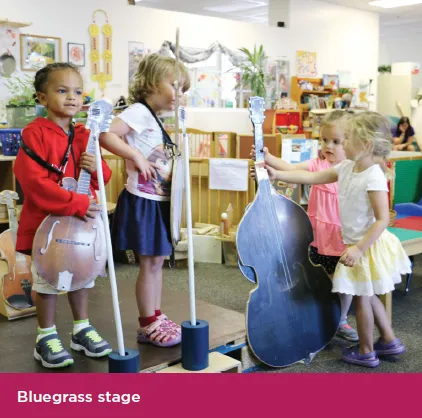
In addition, the teachers moved the dramatic play center near the block area to open the center for more flexible play involving the block area. This allowed children to extend their thinking about using a bluegrass stage for performing to thinking about performing in a community or in various cities alongside the many roads children were continuously building. A variety of photos of bluegrass performers and instruments were also provided to spur children’s thinking in the block area.
The top photo below illustrates the way teachers in one classroom creatively use a shelf to divide and link materials to two centers (writing and art) so that children can choose from a variety of marking tools for writing or creating artwork. The materials cart that is set in front of the metal easel, shown in the bottom photo below, divides the easel into two sections. This provides a visual cue that two children might work here—one on either side of the cart.
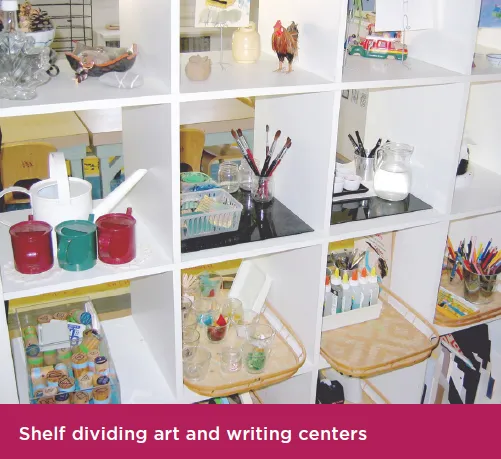
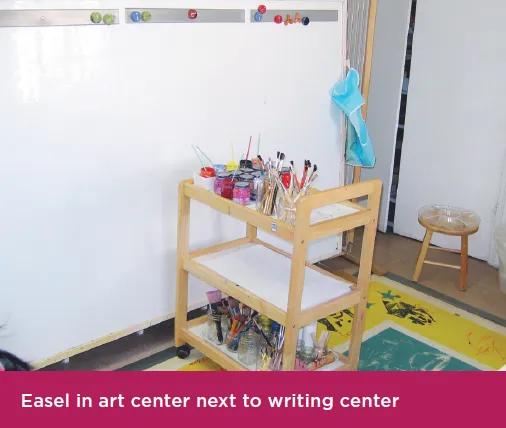
Dramatic play centers can be redesigned over and over to accommodate children’s changing interests. Home living is often a first choice for a learning center early in the year as it draws on what may be familiar to children at home, allowing them to explore within the context of their family home and culture. The realistic and natural look of the kitchen home living center in the top photo below helps the children in this classroom context connect their representations to their experiences at home. Adapt the home living space to include items that represent the diverse family cultures in your classroom and the children’s communities.
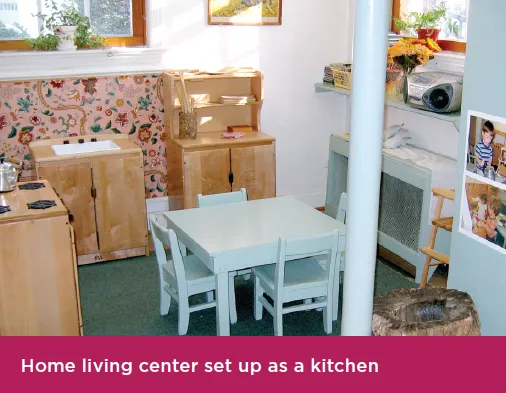
In the block center shown in the photo below, the blocks are clearly organized according to shape. Having two building surfaces, the floor and a platform, allows a variety of ways for children to be comfortable and invites different types of thinking. The teachers in this classroom have added a variety of interesting materials on a shelf to the right of the platform, such as stones, cylinders, and wooden knobs, to encourage diverse approaches for children’s constructions (see the photo on the following page).
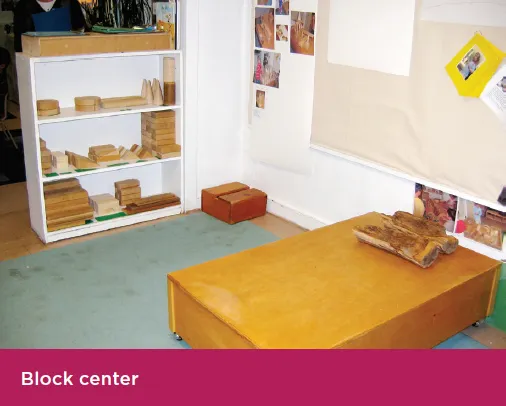

These examples illustrate a few options where teachers intentionally considered the materials to present and ways to organize those materials in the centers to be inviting and to provoke creativity and inquiry (Curtis 2017). This is known as a provocation—the intentional setup of materials within a learning center to elicit the threads of inquiry, the learning that emerges from the children. Setting up provocations allows the children to do more on their own and encourages them to think of different ways of using the materials. When children have a variety of materials to investigate and can initiate their own activities, teachers have greater opportunity for using the COI practices of observation and documentation to support their reflection on the children’s emergent learning. You’ll learn more about provocations and threads of inquiry in Chapter 3.
Open-Ended Materials
While emergent inquiry teachers start off the school year with learning centers that are typical of many early childhood programs, their choices of materials are less commercial. Open-ended materials have the ability to transform from one purpose to another. A block can become a telephone, a vehicle, or a house. While open-ended materials challenge children to explore in diverse ways and to represent their thinking independently or in collaboration with peers, the ways a teacher intentionally sets up the materials can influence the types of thinking that might be explored.
Natural materials are favored open-ended choices in emergent inquiry settings. Think of incorporating branches into the block area where they might become trees or borders for roads, among many other possibilities. Branches in the art area might replace pencils to create an image with lines by dipping the end of the branch into paint. Pinecones or shells in a block area may lead to their use as people or to decorate complex block structures, and when they are placed in a bowl or pan in a home living center they can represent food. Arranging all these materials together in a quiet section of the room or in a manipulatives area will encourage children to touch them, experience and discriminate their textures, or sort according to patterns they notice. In these examples, teachers are helping children to understand that they can use familiar materials in new ways.
Children’s Competence
Working with children around their inquiry leads you to recognize and value how much they know, their eagerness to investigate and explore, and their competence with materials. Emergent inquiry teachers recognize that children are competent with many materials that might not be found in typical early childhood classrooms, such as small paintbrushes; permanent artist-grade felt-tipped markers; high-quality art papers; and a large variety of paint colors. Introduce new materials to children by modeling in ways that allow children to learn the appropriate attitude for responsible use while also being able to explore the tool creatively with autonomy (Baker & Davila 2018). As you learn to observe with intention, you will gain insights into ways to model in relation to children’s inquiry focus, which you will learn about in Chapters 4–7.
In small or whole group meetings, or with individual children, introduce materials like black pens, paint, or clay before you set them out for independent exploration. Use the tool or material yourself along with a think-aloud strategy of telling children what you are doing as you model the processes. For example, with an artist-grade fine-tip black pen, you might say, “As I draw without pressing hard on the pen, I get a thin line, and when I press harder the line gets darker and thicker. I don’t want to press too hard, because I will bend or break the tip and I won’t be a...